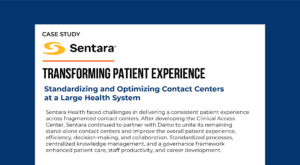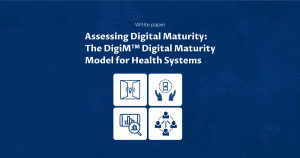Defining the post-COVID-19 digital transformation of healthcare

The scramble to support a predominantly remote care model is now giving way to a more measured evaluation of telehealth technologies
In the wake of COVID-19, the initial scramble to lock down hospitals and clinics and switch to a predominantly remote care model is now giving way to a more measured assessment of healthcare needs of the population, evaluation of the care delivery models using telehealth technologies as enablers, and a long-term survival strategy for hospitals and health systems.
My firm’s work with healthcare enterprises through the pandemic response over the past several months points to an emerging equilibrium that balances the needs for in-person care with the desire to continue with virtual care models as hospitals grapple with the question of a return to profitability and growth.
Virtualization of care will penetrate deeper into healthcare services, but there will be limits.
In a recent blog post in Health Affairs, CMS administrator Seema Verma shared some initial data on telehealth visits immediately following the pandemic. Before the public health emergency, approximately 13,000 beneficiaries in fee-for-service (FFS) Medicare received telemedicine in a week. By the end of April, this number had risen to nearly 1.7 million. As clinicians and patients get used to telemedicine, all other forms of virtual care are set to penetrate deeper into healthcare services, specifically low-acuity and preventative care that is ambulatory in nature.
A handful of companies, notably Teladoc and American Well, have seen demand soar for their platform offerings. Other non-traditional players, such as Microsoft and Zoom, are aggressively moving into the telehealth space.
In-person care experiences have been augmented/replaced by telehealth models such as telestroke, teleradiology, and telepsychiatry. A new generation of digital health startups has developed intuitive smartphone apps to deliver these services and integrate them seamlessly with core EHR platforms for scheduling and other functions. Remote monitoring for chronic care populations is set to increase as COVID-19 limits access to care for some of the most high-risk populations with multiple comorbidities.
However, telehealth has its limits. Telemedicine has become the norm for low-acuity and preventative care in urban and suburban areas with populations with access to high-speed internet connectivity and smartphone-enabled apps. In rural areas, though, poor internet connectivity and the lack of bandwidth coverage means that patients have to come into physical facilities for care. Individual segments of our population, such as the elderly, are unable or unwilling to accept telehealth. Lastly, some forms of care cannot be delivered remotely. As CMS administrator Verma states, telehealth cannot replace gold-standard in-person care.
Telehealth and remote monitoring programs will increase but will need active public-private participation.
Indigent populations, constrained by affordability and access to bandwidth, have also had to bear the brunt of the COVID-19 crisis, leading to several public initiatives to improve bandwidth availability as well as access to devices to bridge the “digital divide.” One such initiative in Chicago aims to provide internet access to over 100,000 students of the Chicago Public School system, indicating there could be multiple benefits from democratizing access to bandwidth.
The FCC’s $200 million telehealth grant program, launched in March 2020, has funded targeted initiatives across the United States supporting medically underserved populations to overcome the impact of COVID-19 on access to care. The program, which has funded 539 applications for the total amount of $200 million approved by Congress, has focused on telehealth, supported in many cases by remote monitoring devices, for rural and indigent populations.
In many cities, such as New York, active public-private collaboration has also enabled improved care for vulnerable populations through data-sharing for rapid response and contact tracing. Syndromic surveillance tools developed by the private sector allow timely identifications of infected individuals and high-risk communities for targeted interventions.
Digital health adoption will increase, but the marketplace needs more.
The expanded Medicare reimbursements for telehealth immediately following the pandemic has been a lifeline for hospitals during the COVID-19 crisis and has spurred investment in telehealth. However, improved reimbursements is only one part of the story for health systems navigating the transition to a virtual care era.
One of the biggest challenges for healthcare delivery today is the need for seamless patient and caregiver experiences using telemedicine technologies. To achieve this, hospitals must go beyond simply optimizing their use of native features in electronic health record (EHR) systems and look at other best-in-class tools and platforms to improve the overall healthcare experience and outcomes. They must look at big tech firms such as Microsoft and Salesforce, which are making significant investments in healthcare-focused features in collaboration and CRM software that can help hospitals enhance the patient experience through improved workflows, faster response times, and increased effectiveness with care management.
The proliferation of digital health tools, especially from startups, has increased the choices for developing and implementing robust digital health roadmaps. The increased use of industry standards such as FHIR for data exchange and the implementation of the CMS final rule on interoperability and patient access will accelerate digital health innovation, and healthcare executives must be prepared to harness the innovation to improve convenience, increase transparency, and enhance the experience.
For healthcare, investing in developing and executing enterprise digital roadmaps may seem overwhelming in the face of heightened financial pressures and a rapidly transforming care delivery model. Consumers want more from healthcare today, pandemic or no pandemic. Healthcare is already behind other sectors such as retailing, ecommerce and banking when it comes to delivering satisfactory experiences for healthcare consumers – online or offline.
The entry of non-traditional players such as Walgreens, which have built seamless online/in-store experiences for consumers in the primary care space, will only raise the bar for incumbents in healthcare. Healthcare enterprises must not only survive the current COVID-19 crisis; they must invest today in building robust digital front doors and other telemedicine capabilities and executing them with carefully considered technology choices to remain competitive in future.
Originally published on CIO














